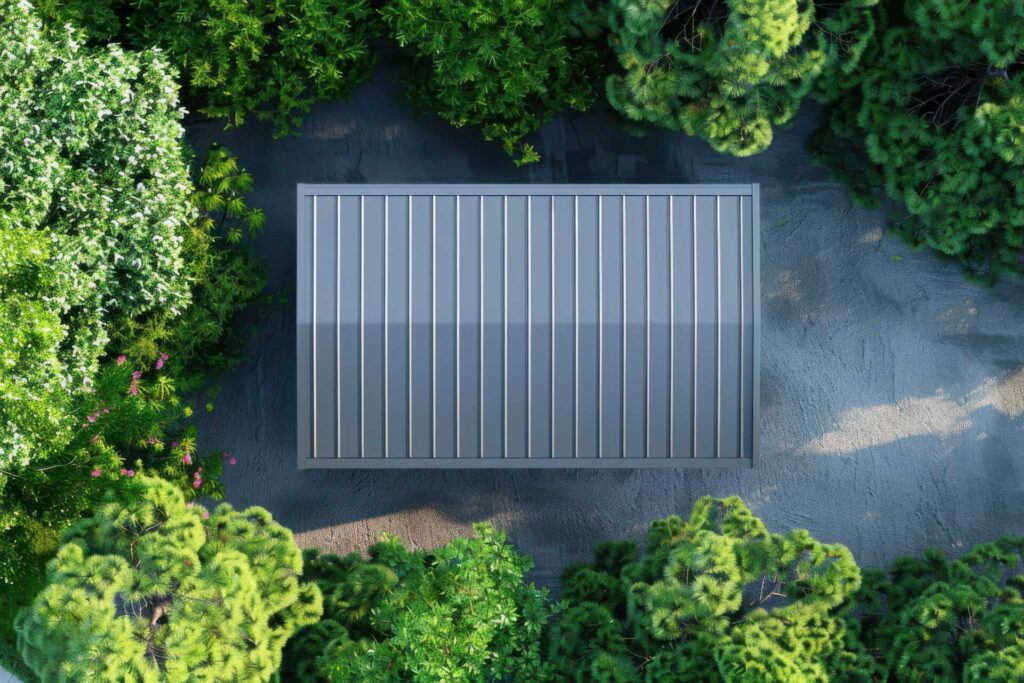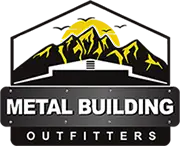
Contents
While traditional homes often require constant upkeep and repairs, residential metal structures stand out with their remarkable durability and low maintenance needs. You might be surprised to learn that these buildings can last over 50 years, providing a solid return on your investment. Beyond longevity, they offer impressive energy efficiency and design flexibility. What’s even more intriguing is how they contribute to both cost-effectiveness and environmental sustainability. Exploring these aspects can reveal why so many homeowners are making the switch to metal for their living spaces.
Key Takeaways
- Metal structures offer exceptional durability, lasting up to 50 years and resisting bending, warping, and environmental challenges.
- They require minimal maintenance, with simple annual inspections and easy cleaning, reducing long-term upkeep costs.
- Cost-effectiveness arises from low repair needs and potential tax benefits, increasing property value over time.
- Energy efficiency is enhanced through advanced insulation and reflective metal roofs, lowering energy consumption and costs.
- Design flexibility allows for unique architectural options and quick construction, accommodating diverse homeowner preferences and faster occupancy.
Exceptional Durability
When it comes to construction, few materials can match the exceptional durability of residential metal structures. These structures are engineered to provide unmatched structural integrity, ensuring they withstand a variety of environmental challenges.
You’ll appreciate how metal’s inherent strength allows for designs that resist bending, warping, or cracking, which often affect traditional building materials.
Choosing metal means choosing long-term performance. Unlike wood, which can succumb to rot or pests, metal structures maintain their form and functionality over time. You don’t have to worry about frequent repairs or replacements, which translates to significant cost savings in the long run.
The robust nature of metal also means it can handle extreme weather conditions, from heavy snow to intense heat, without compromising safety or stability.
Moreover, metal is resistant to fire, adding another layer of safety to your investment. In an era where building codes are increasingly stringent, opting for residential metal structures ensures compliance while providing peace of mind.
You’ll find that this durability enhances property value, making your home a more attractive option for future buyers.
Low Maintenance Requirements
When you choose residential metal structures, you’re investing in materials known for their durability and longevity, which greatly reduces your upkeep efforts.
These structures require minimal maintenance due to their robust construction and weather-resistant features.
As a result, you’ll spend less time on repairs and more time enjoying your space.
Durable Material Longevity
Residential metal structures are engineered for longevity, providing homeowners with a low-maintenance solution that stands the test of time. The material strength of metal ensures that your structure can withstand various weather conditions, preventing issues like rotting, warping, or insect damage commonly found in traditional building materials. This durability translates into longevity benefits, allowing you to enjoy your investment without the constant worry of repairs.
Consider the following table that outlines the key material strengths of metal versus traditional materials:
| Material Type | Durability Features |
|---|---|
| Metal | Resistant to rust, pests, and decay |
| Wood | Prone to rot, pests, and warping |
| Concrete | Can crack and crumble over time |
| Vinyl | May fade and become brittle |
| Brick | Susceptible to moisture damage |
Minimal Upkeep Needed
One of the standout advantages of metal structures is their minimal upkeep requirements, making them an ideal choice for busy homeowners. Unlike traditional materials, metal doesn’t demand frequent maintenance. You’ll find that a simple maintenance schedule suffices to keep your structure in top condition. Typically, an annual inspection is all you need to ensure everything is functioning properly.
When it comes to cleaning techniques, you’ll appreciate that metal surfaces are easy to manage. A quick rinse with water and a gentle detergent will remove dirt and debris, maintaining the structure’s aesthetic appeal. There’s no need for specialized cleaning agents or extensive scrubbing, which saves you both time and effort.
Moreover, metal’s resistance to pests and rot means you won’t be troubleshooting issues related to termites or mold, common concerns with wood structures. This reliability allows you to focus on enjoying your space rather than worrying about repairs.
Weather Resistance Features
Weather resistance is an essential feature of metal structures that enhances their low maintenance profile. When you invest in a residential metal structure, you’re securing a building that can withstand various weather conditions. With impressive storm resistance and temperature stability, these structures require minimal upkeep, allowing you to focus on what truly matters in your life.
Here’s a quick comparison of weather resistance features:
| Feature | Metal Structures | Traditional Materials |
|---|---|---|
| Storm Resistance | High | Moderate |
| Temperature Stability | Excellent | Varies |
| Maintenance Needs | Low | High |
Metal structures are engineered to resist the harshest elements, from heavy rain to extreme heat. Unlike traditional materials that may warp or corrode, metal remains robust and reliable over time. This durability translates to fewer repairs and replacements, ultimately saving you both time and money. By choosing a metal structure, you’re embracing a future where weather challenges are no longer a concern, fostering a sense of belonging and security in your home.
Cost-Effectiveness Over Time
Investing in metal structures often proves to be a cost-effective choice over time. When you consider the durability and low maintenance requirements of metal buildings, you’ll find they offer significant long-term savings compared to traditional materials.
Unlike wood or vinyl, metal isn’t susceptible to rot, pests, or extensive weather damage, which means you won’t be spending money on repairs or replacements frequently. This aspect alone makes it a smart financial investment for homeowners looking to minimize unforeseen expenses.
Moreover, the longevity of metal structures contributes to their cost-effectiveness. Many metal buildings come with warranties that span decades, ensuring that your investment remains protected.
In contrast, other materials may require more frequent replacements, leading to higher cumulative costs over time. By choosing metal, you’re not just purchasing a structure; you’re securing peace of mind regarding your financial future.
Additionally, metal structures often have lower insurance premiums due to their fire resistance and overall strength. This can further enhance your long-term savings, as you’ll pay less in insurance costs while enjoying the benefits of a robust living space.
Energy Efficiency Features
Energy efficiency is a standout feature of residential metal structures, making them an attractive option for environmentally conscious homeowners. These structures are designed with energy conservation strategies in mind, ensuring you can minimize energy consumption while maximizing comfort.
One significant advantage of metal homes is their ability to incorporate advanced insulation materials. You’ll find that high-performance insulation options, such as spray foam or rigid foam boards, can dramatically reduce heat transfer. This means your home stays warmer in winter and cooler in summer, allowing you to rely less on heating and cooling systems. Consequently, you’ll enjoy lower energy bills and a reduced carbon footprint.
Another aspect contributing to energy efficiency is the reflective nature of metal roofs. They can effectively redirect solar energy, preventing excessive heat buildup during hot months. When you combine this with strategically placed windows and shading techniques, you’ll create a home that maintains a comfortable internal climate year-round.
Additionally, metal structures can be designed to optimize natural light, reducing the need for artificial lighting during daytime hours. By thoughtfully integrating these energy conservation strategies, you’ll enhance your living experience and promote sustainability.
Design Flexibility and Customization
The architectural possibilities with residential metal structures are vast, allowing homeowners to create a unique living space that reflects their personal style and preferences. With numerous design options available, you can easily customize your home to meet your functional needs while showcasing your individuality.
Whether you prefer a modern, minimalist look or a more traditional aesthetic, metal structures can adapt to your vision. You can incorporate custom features such as large windows, open floor plans, and unique rooflines that enhance both the functionality and beauty of your residence. The flexibility of metal allows for innovative design solutions that standard building materials simply can’t match.
| Design Options | Custom Features | Emotional Impact |
|---|---|---|
| Open-concept layouts | Skylights for natural light | Bright, inviting atmosphere |
| Unique roof styles | Energy-efficient insulation | Cozy, comfortable living |
| Large, panoramic windows | Customizable interior layouts | Personal connection to space |
| Varied exterior finishes | Smart home integration | Modern, integrated lifestyle |
Choosing a residential metal structure means you’re not just building a house; you’re crafting a home that resonates with your identity. The ability to tailor every aspect of your living space fosters a sense of belonging and pride. With endless design options and custom features at your disposal, your vision can come to life, ensuring your home isn’t just a place to live but a true reflection of who you are.
Resistance to Pests and Rot
Residential metal structures stand out for their remarkable resistance to pests and rot, ensuring durability and longevity.
When you choose metal for your residential needs, you’re investing in a material that naturally deters pests such as termites, rodents, and other wood-destroying insects. Unlike traditional wood, metal doesn’t provide a food source or nesting ground, making it an effective pest deterrent. This inherent quality saves you the hassle and cost associated with pest control treatments over time.
Additionally, rot prevention is a considerable advantage of metal structures. Wood is susceptible to moisture, which can lead to rot and decay, compromising the integrity of your home.
In contrast, metal is non-porous and resistant to moisture, considerably reducing the chances of mold and mildew development. This characteristic is particularly advantageous in climates that experience high humidity or frequent rainfall.
Fire Safety Advantages
One of the standout features of metal structures is their impressive fire safety advantages. Unlike traditional wooden buildings, which are highly susceptible to fire, metal structures are inherently more resistant. The use of fire retardant materials in their construction enhances this capability, providing you with added security and peace of mind.
As a homeowner, knowing that your residence can withstand higher temperatures before succumbing to flames is invaluable. Metal structures don’t ignite easily, which greatly reduces the risk of a fire spreading rapidly. This advantage is essential during an emergency evacuation, allowing you and your loved ones more time to escape safely.
In the unfortunate event of a fire, the non-combustible nature of metal can help contain the blaze, protecting your property and reducing damage. Moreover, many metal building systems come with coatings that further increase their fire resistance. These coatings are designed to withstand extreme heat, giving you an additional layer of protection.
When you choose a residential metal structure, you’re investing in a home that prioritizes safety and durability. Your community’s safety is also enhanced by the fire safety advantages of metal structures. With reduced fire risks, you’re contributing to a safer environment for your neighbors and future residents.
Essentially, opting for a metal structure safeguards your family and fosters a sense of belonging and responsibility within your community. Choose wisely—your home’s fire safety should never be compromised.
Quick Construction Process
Accelerating your construction timeline, metal structures offer a considerably quicker building process compared to traditional methods. One of the primary reasons for this efficiency is the use of prefabricated components. These components are manufactured off-site, allowing for a streamlined assembly on your property.
When you choose metal for your residential structure, you’re opting for a design that minimizes on-site work and reduces the likelihood of construction delays.
With prefabricated components, you can expect a reduction in labor time and costs. Since the parts are built in a controlled environment, they’re produced with precision, ensuring that they fit together seamlessly during assembly. This results in fewer adjustments and less waste, which means you can enjoy your new space sooner.
Moreover, metal structures are often designed for easy assembly. Many come with pre-drilled holes and clear instructions, making the installation process straightforward.
This simplicity shortens the construction timeline and allows for flexibility in scheduling. You won’t have to worry about inclement weather causing delays as much as you’d with traditional building materials.
Sustainable Building Material
When considering residential metal structures, you’ll find that their recyclability and durability greatly contribute to sustainable building practices.
These materials enhance energy efficiency and minimize environmental impact throughout their lifecycle.
Recyclability and Durability
Residential metal structures stand out as sustainable building materials due to their exceptional recyclability and durability. When you choose metal for your home, you’re opting for a product that considerably contributes to environmental benefits, as most metal can be recycled repeatedly without losing its quality. This helps reduce waste in landfills and conserves natural resources.
Here’s a quick overview of how metal structures stack up against traditional materials:
| Aspect | Metal Structures | Traditional Materials |
|---|---|---|
| Recyclability | Highly recyclable | Limited recyclability |
| Durability | Long-lasting (50+ years) | Shorter lifespan |
| Environmental Impact | Low (less waste) | High (more waste) |
Energy Efficiency Advantages
Metal structures excel in recyclability and durability and offer considerable energy efficiency advantages. When you choose a metal building, you’re investing in a structure designed for peak energy performance.
Here are three key aspects to evaluate:
Solar Panel Integration: Metal roofs are ideal for solar panel installation. Their durability and lightweight nature allow for easy attachment, maximizing energy capture and efficiency.
Insulation Options: Metal buildings can accommodate various insulation solutions, including reflective insulation and spray foam. These options help maintain comfortable indoor temperatures, reducing heating and cooling costs considerably.
Energy Efficiency Ratings: Many metal structures come with energy-efficient designs that meet or exceed industry standards. This lowers your energy bills and can enhance your property’s value and marketability.
Low Environmental Impact
Sustainable building materials play an essential role in reducing environmental impact, and metal structures are at the forefront of this movement. By choosing metal for your residential projects, you’re embracing sustainable practices that minimize waste and promote eco-friendly materials. Metal is highly recyclable, with a lifespan that often surpasses traditional building materials, which means you’re making a long-term investment in the planet’s health.
Here’s a quick comparison of metal structures versus traditional materials:
| Feature | Metal Structures |
|---|---|
| Recyclability | 100% recyclable |
| Lifespan | Up to 50 years or more |
| Energy Efficiency | Reflects heat, reduces cooling costs |
| Maintenance | Minimal upkeep required |
Opting for metal structures supports eco-friendly initiatives and contributes to a sense of community responsibility. You’re aligning your choices with a broader movement towards sustainability, enhancing both your living space and the environment. From reduced carbon footprints to lower resource consumption, metal buildings are a smart choice. Embrace these benefits, and feel good about your impactful decision.
Review
Embracing residential metal structures is like investing in a sturdy fortress for your future. Their exceptional durability, low maintenance, and cost-effectiveness create a solid foundation for long-term savings and peace of mind. With energy-efficient features, customizable designs, and resistance to common hazards, these homes are not just practical; they reflect a commitment to sustainability. By choosing metal, you’re not just building a house; you’re crafting a resilient, modern lifestyle that stands the test of time.
Recent Posts
Maximize Efficiency With Strong Metal Agricultural Structures
You might not realize that metal agricultural structures can drastically reduce your operational costs while
Custom Metal Garages for Unique Storage Solutions
You might think a custom metal garage is just a box for your car, but
3 Tips for Personalized Metal Garage Solutions
Finding personalized metal garage solutions can transform your cluttered space into a functional haven. By




